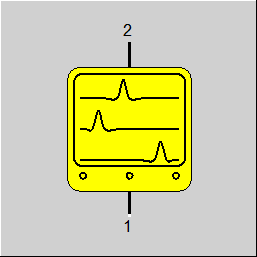

|
Line connections |
|
|
|
1 |
Logic Inlet (connection to measured stream) |
|
|
2 |
Logic Outlet (H = value of calculated maximum dew point) |
|
General User Input Values Physics Used Displays Example
Component 136 determines the water dew point as well as several acid dew points from the composition of the stream that is connected through a logic line at port 1. The maximum dew point resulting from the correlations for all liquids involved can be read from a logic outlet at port 2, for instance to serve as an input for a controller unit. The Emission Display enables the calculation of the emissions of various gaseous components based on a user-specified basis for the oxygen and water content of the gas stream under reference conditions.
|
SO2SO3CONV |
SO2 to SO3 conversion (molar ratio of sulfur trioxide formed from the incoming sulfur dioxide) |
|
FH2SO4 |
Sulfuric acid dew point method
|
|
WACDVER |
Weight sulfuric acid dew point by Verhoff and Banchero (1974) |
|
WACDZAR |
Weight sulfuric acid dew point by ZareNezhad (2009) |
|
WACDHAA |
Weight sulfuric acid dew point by Haase |
|
WACDABB |
Weight sulfuric acid dew point by ABB |
|
WACDMAR |
Weight sulfuric acid dew point by Martin |
|
WACDOKK |
Weight sulfuric acid dew point by Okkes (1987) |
|
FNORMO2 |
Scaling to reference O2 concentration
|
|
O2REF |
Reference O2 concentration (molar) |
|
FUNIT |
Emission concentration unit of measure
|
| ACDEWVER | Sulfuric acid dew point temperature according to Verhoff and Banchero (1974) |
| ACDEWZAR | Sulfuric acid dew point temperature according to ZareNezhad |
| ACDEWHAA | Sulfuric acid dew point temperature according to Haase |
| ACDEWABB | Sulfuric acid dew point temperature according to ABB |
| ACDEWMAR | Sulfuric acid dew point temperature according to Martin |
| ACDEWOKK | Sulfuric acid dew point temperature according to Okkes (1987) |
| ACDEWH2SO4 | Sulfuric acid dew point temperature (calculated as per setting FH2SO4) |
| ACDEWH2SO3 | Sulfurous acid dew point temperature |
| ACDEWHNO3 | Nitric acid dew point temperature |
| ACDEWHCL | Hydrochloric acid dew point temperature |
| TDEW | Water dew point temperature |
| ACDEWMAX | Maximum dew point temperature (of all liquids, will be written to enthalpy of logic line at port 2) |
| M_i | Mass flow of component i (i= CO2, CO, SO2, NO, NO2, N2O, NH3, H2O, HCl) |
| Y_i | Concentration of component i (i= CO2, CO, SO2, NO, NO2, N2O, NH3, H2O, HCl) |
The formulas for the calculation of dew points of the various acids are given below, where T denotes the acid dew point temperature in Kelvin, and P denotes the partial pressure of the respective flue gas component in mm Hg (Torr).
Sulphuric acid dew point according to Verhoff and Banchero (1974):

Sulphurous acid dew point according to Yen Hsiung Kiang (1981):



In order to expose the maximum calculated dew point for control algorithms in the model during the calculation, the maximum value of all active equations (i.e. for the sulfuric acid dew point the value that has been defined according to method FH2SO4) is written to the enthalpy value of the logic line connected at port 2, which allows for utilizing this value with a defined offset as a target value for a controller for the feed water inlet temperature into the coldest preheater. At the end of the calculation this maximum value is also written to the result value ACDEWMAX.
In the emission calculation, the mass fractions of the components carbon dioxide (CO2), carbon monoxide (CO), sulfur dioxide (SO2) , nitrogen monoxide (NO), nitrogen dioxide (NO2), nitrous oxide (N2O), ammonia (NH3), water (H2O), and hydrochloric acid (HCl) are converted to a user-defined unit of measure for concentration (selectable from the method FUNIT) with user-defined reference oxygen concentration (selectable from the method FNORMO2). The reference state for the standard volume for the emission calculations is 0°C (32 F) and 1 atm (1013.25 mbar, 14.696 psia) in accordance with DIN 1343.
Important Notice: Although the units of measure for the result variables Y_i change immediately after a change in the setting for the emission concentration unit of measure (FUNIT), the model MUST be executed to produce the correct emission concentrations, since the values must be re-calculated based on the current settings of the parameters FNORMO2, O2REF, and FUNIT.
Verhoff and Banchero (1974)
Verhoff, F.H., and Banchero, J.T., "Predicting dew points of flue gases," Chemical Engineering Progress, Vol. 70 (1974), pp. 71-72
ZareNezhad (2009)
ZareNezhad, B., “New correlation predicts flue gas sulfuric acid dew points”, Oil&Gas Journal, Vol. 107 (35), 60-63, 2009
Okkes (1987)
Okkes, A.G., "Get acid dew point of flue gas," Hydrocarbon Processing, Vol. 7 (1987), pp. 53-55
Yen Hsiung Kiang (1981)
Yen Hsiung Kiang, "Predicting Dew points of Gases", Chemical Engineering Vol. 88, Issue 3 (1981), p. 127
 |
Display Option 1 |
||
Click here >> Component 136 Demo << to load an example.